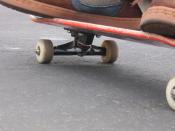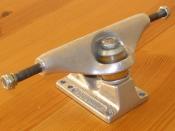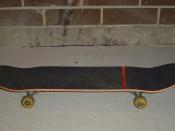Skateboarding is a sport in which somebody rides a board that is made out of different layers of wood and has wheels on it. Skateboarding has been around since the early 1950's and originated from surfing. There is a surprising amount of physics involved in this sport. All of Newton's laws, momentum, projectile motion, rolling friction, sliding friction, static friction, air resistance, gravity, potential and kinetic energy, and work are all involved in skateboarding and how skateboarding works altogether. I will explain the physics involved in riding around on a skateboard, the physics of different tricks and techniques, and also the physics of why one would fall while skateboarding.
There are many principles of physics involved in riding around on a skateboard. All of Newton's laws, rolling friction, sliding friction, air resistance, center of gravity, linear motion, and momentum. The wheels on a skateboard are made from a substance called urethane, which helps the wheels grip the ground so that the wheels do not slip as easily.
Sometimes, though, the skateboard will slide against the concrete, but it usually does not slide far or fast enough for the skateboarder to fall off or be thrown off balance for a second or two. There are three different laws that were developed by Sir Isaac Newton. The first law is Newton's Law of inertia. This law states: "Every object continues in a state of rest, or of motion in a straight line at a constant speed, unless it is compelled to change that state by forces exerted on it." This essentially means that unless somebody or something puts a force on a certain object of matter it will either stay at rest or keep moving. If there is a skateboard just lying around somewhere that skateboard will not move unless somebody...



Nice essay
Pretty good work. I like it.
1 out of 1 people found this comment useful.